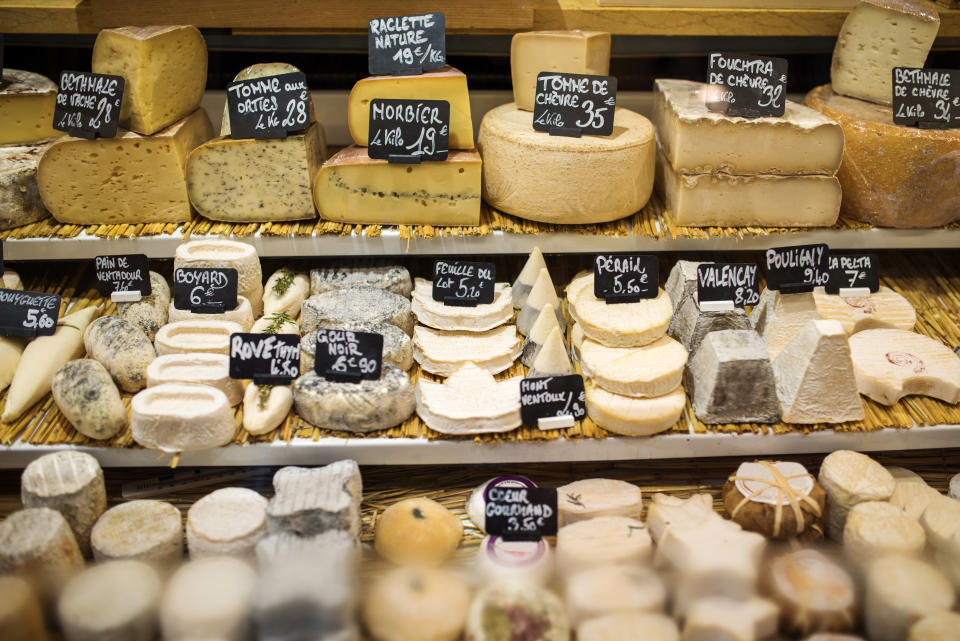You’ve been stacking your fridge wrong

Putting your groceries away shouldn’t be a huge task, and yet the internet is filled with contradictory information about how to keep your produce fresher for longer.
Don’t store potatoes alongside onions, eggs belong on the kitchen counter, and don’t you dare keep your milk in the fridge door, are just some of the tidbits you’ll read.
Nutritionist Dr Joanna McMillan helps Yahoo Lifestyle navigate the dos and don’ts of food storage, with a definitive list of where to keep what.
Milk
The door of your fridge can be a problematic place as the temperature isn’t as stable as it is on the middle or bottom shelves – especially if you have kids running around the house constantly pulling the door open. This has led many to believe it’s a sin to keep your milk in the fridge door where the slightly warmer temperatures may cause it to spoil sooner, but Dr Jo says you shouldn’t heed this warning.
READ MORE: Should you put your eggs in the fridge?
The convenience of having your milk within easy reach once you open the fridge is worth the slight flux in temperature, she says, not to mention the fact that keeping open bottles of milk laying down on the bottom shelves could create spills if the lid isn’t on properly.
“If you hardly ever use milk and are just putting a splash in your coffee, or if you’ve got an extra bottle of milk that is not yet open, then I’d keep that on one of the middle shelves so it stays at a more stable temperature,” Dr Jo says, otherwise, “You want it to be handy.”
The same applies for plant-based milks which have a long shelf life before they are opened, but should be consumed within a week once you break that seal. If your favourite brand comes in a tetra pack carton without a lid, like popular soy milk brand Bonsoy does, you could always consider transferring the contents into a sealable container if you want to keep it fresher for a little longer.
Cheese
Cheese connoisseurs will love this tip for preserving the flavour of your favourite fromage. Dr Jo recommends taking hard, medium-hard and semi-soft cheeses out of plastic wrappings and instead covering them in baking paper. She then places all her cheeses in their own sealed Tupperware container in the fridge, and changes over the paper if it happens to get wet.
“Cheeses are high fat foods and when you’ve got something fatty, you’ve got a risk of things migrating into that fat,” she says, “So you can get some plastic leaching and might get the flavour of the plastic [in the cheese].”
“You also don’t want cheese to sweat, if you go to a cheese producer in France, they never have their cheese wrapped in plastic, you want the cheese to be able to breathe.”

Eggs
Modern fridges come stocked with perfectly-shaped holders to keep your eggs, but Dr Jo says you’re better off removing that tray altogether and keeping your eggs on your kitchen bench.
“Almost every fridge comes with these egg trays, but the thing with eggs is that their shells are very porous, so if you’ve got something really strong flavoured or smelling in the fridge, it can get into the egg,” Dr Jo explains - although she does defy anyone to actually taste the difference.
If you get through a carton of eggs fairly quickly, she says keeping them on your kitchen bench or in the pantry is perfectly acceptable and some would argue that it’s even the better option when using them for baking or poaching.
READ MORE: Mum's tips for an impeccably organised fridge
However, if your house is very warm or you need them to store for longer, then she recommends keeping them inside the cardboard carton they come in so that their flavour isn’t compromised by the other contents of your fridge.
The British Egg Information Service believes the only place to keep food cool and avoid temperature fluctuations is the fridge.
Sauces
Debate also rages within households over whether to keep your tomato sauce in the fridge or the pantry, and it turns out, either is actually fine provided your pantry is relatively cool.
High sugar or salt contents in bottled sauces like ketchup and BBQ sauce, prevent a lot of bacteria from growing and therefore give them a long shelf life outside of the fridge.
The same goes for soy sauce, oyster sauce and fish sauce, as well as jams and honey. Maple syrup on the other hand, should probably be kept in the fridge once opened and the door will do just fine as a home.
Just be aware of low sugar and low salt varieties of sauces like tomato sauce, Dr Jo adds, as these may do better in the fridge if they don’t have added preservatives, but it’s always best to read the label.
For things like mayo, she says squeezy bottles help keep the contents fresher for longer when compared to jars, as they stop air and bacteria from getting in and don’t involve you constantly scooping it out the contents with a spoon.

Healthy food
Making healthy options readily available and easy to see, is the key to forming healthy eating and snacking habits, Dr Jo says.
“Everyone thinks they need to have enormous willpower to eat healthily, but actually the truth of the matter is that it’s all about habits and making things easy,” she explains.
The trick is to keep healthy snacks front and centre in your fridge so you can open the door at any time and see hummus and carrot sticks for example, sitting right in the middle of the top shelf, waiting to be eaten.
Likewise, “if you open the fridge and see dairy desserts or chocolate mousse, that’s immediately in my mind, and even if I have the willpower to go, ‘I’m not going to eat that right now’, I’ll go back to my desk going, ‘that mousse would be really good right now’,” she says.
We make around 200 food choices a day, Dr Jo explains, most of which we’re unaware of thanks to messages we see in the world around us. For example, if you see your friend munching on an ice cream, you’re more likely to want one too. So flooding your mind with healthy options when you’re at home will naturally make eating more healthily an easier task.
Sweet treats
Just as you want healthy foods to hit you in the face when you first open the fridge, Dr Jo likes to keep her little sweet treats hidden away in the locked, family safe compartment, so they aren’t front of mind.
READ MORE: Veganism has quadrupled in four years – but what’s behind it?
“One of the tips I give in terms of trying to eat healthily is to remove the temptation,” she says, “out of sight, out of mind.”

Raw meat
Raw seafood and meat is best kept on the lower shelves of your fridge to avoid contamination from any spillage, particularly in fridges that don’t have ‘spillsafe’ lips that keep stray liquids confined to the one shelf.
“A really good rule of thumb is to keep raw stuff on the lower shelf,” Dr Jo says, “If you’ve got wrapped meat from the butcher or an open packet of raw meat, what you don’t want are raw juices from meat or seafood dribbling into anything that you might eat raw like fruit, or something that you’re only reheating for a couple of minutes in the microwave.”
The middle and lower shelves are also more stable temperature-wise, with the top shelf and the door being the places where the temperature fluctuates the most.
When it comes to buying meat and seafood, Dr Jo recommends purchasing bulk pieces from your local butcher and fish monger, and spending the time cutting them into smaller portions, vacuum sealing them, and then storing them in either the fridge or freezer.
This will not only keep your produce fresher for longer, but can save you save money on high quality meat and seafood, with Dr Jo saying she saves by buying a whole side of salmon and portioning it herself, rather than purchasing individual serves.
Veggies
Potatoes and onions are easily kept in a cool dark place in the pantry to save space in your fridge for more delicate veggies like leafy greens. That said, potatoes and onions should always be kept in separate baskets or containers as they can spoil more quickly when stored together.
Most fruit is fine to keep on the bench too, Dr Jo says, unless it’s cut or already ripe and you want to store it for longer.
Broccoli, lettuce, leafy greens, capsicums, eggplants and the like, are all best kept in the crisper draw of your fridge – and if you have a variable setting on yours, use it.
READ MORE: This hygiene question has the internet divided
“Flick the humidity to ‘high’ so it keeps as much moisture in there as possible, and it only goes to ‘low’ if you’ve got things (like ripe fruit) producing gasses and you want to release the gasses,” Dr Jo says.
Greens that are bought in sealed salad bags don’t need to go in the crisper and can stay on a shelf, and if you don’t have enough space in your crisper for all your delicate veg, you could put them in sealed Tupperware containers with a piece of paper towel at the top and bottom. Lettuces bought whole last longer (and involve less plastic waste) than those purchased in bags, particularly if you don’t wash them until you’re ready to use them, but one advantage of the bagged varieties is that they often come with a variety of different types of lettuce, which Dr Jo is a fan of.
Mushrooms are best left in brown paper bags, and Dr Jo recommends buying them in those bags rather than in the pre-packed plastic containers as the latter causes them to sweat and their quality to deteriorate more quickly.
While in a similar category to leafy greens, Dr Jo actually advises we buy herbs as little pots in soil, rather than as cut bunches when you’re not planning on using all of it at once. This way, she says, you can keep the pot on your windowsill (and keep it hydrated and alive) until you’re done using the whole crop, as herbs have a notoriously short shelf life once cut. If you do buy them cut, wrap leftovers in damp paper towel and store in a zip lock bag to maintain freshness for as long as possible.
Leftovers
Last but not least, Dr Jo recommends keeping leftover meals on the middle or bottom shelves of the fridge and eating them within three days.
She advises that all leftovers be heated up until piping hot all the way through, and best practice when microwaving is to zap until hot, then take the leftovers out and let them stand for 30 seconds, stirring well, and then heat again until very hot throughout.
Rice in particular shouldn’t be kept for more than three days, she says, but you can freeze rice straight after cooking for easy leftovers.


